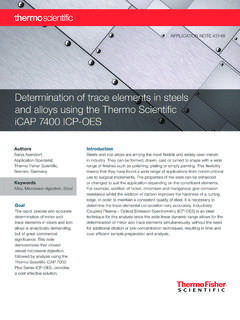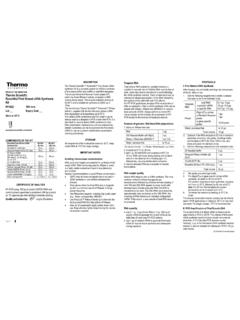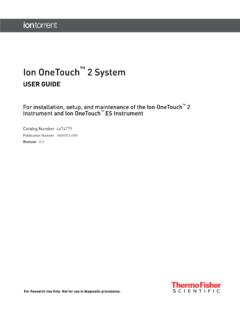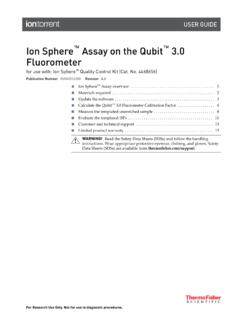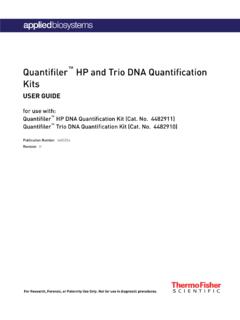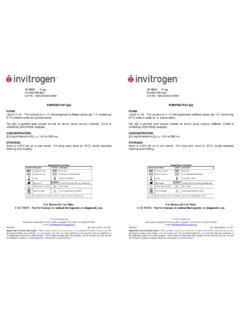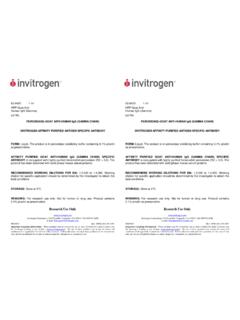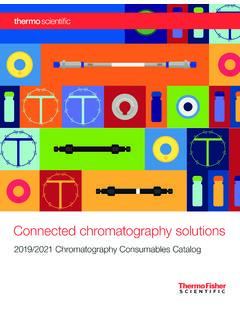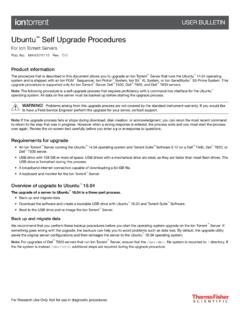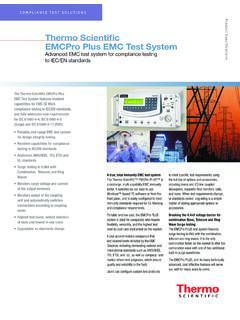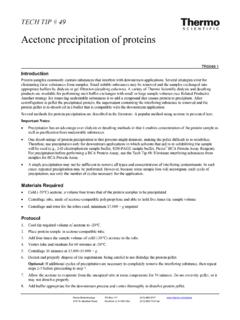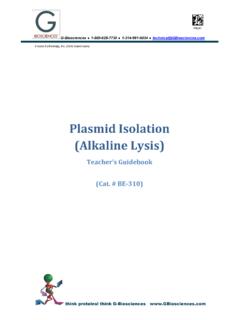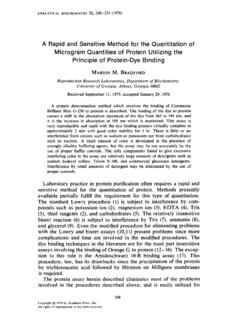Transcription of TRIzol Reagent Product description - Thermo Fisher Scientific
1 TRIzol ReagentCatalog Numbers 15596026 and 15596018 Doc. Part No. Pub. No. MAN0001271 Rev. ! Read the Safety Data Sheets (SDSs) and follow thehandling instructions. Wear appropriate protective eyewear,clothing, and gloves. Safety Data Sheets (SDSs) are availablefrom descriptionInvitrogen TRIzol Reagent is a ready-to-use Reagent , designed toisolate high quality total RNA (as well as DNA and proteins) from celland tissue samples of human, animal, plant, yeast, or bacterial origin,within one hour. TRIzol Reagent is a monophasic solution of phenol,guanidine isothiocyanate, and other proprietary components whichfacilitate the isolation of a variety of RNA species of large or smallmolecular size.
2 TRIzol Reagent maintains the integrity of the RNAdue to highly effective inhibition of RNase activity while disruptingcells and dissolving cell components during sample Reagent allows for simultaneous processing of a large numberof samples, and is an improvement to the single-step RNA isolationmethod developed by Chomcynski and Sacchi (Chomczynski andSacchi, 1987). TRIzol Reagent allows to perform sequential precipitation of RNA,DNA, and proteins from a single sample (Chomczynski, 1993). Afterhomogenizing the sample with TRIzol Reagent , chloroform is added,and the homogenate is allowed to separate into a clear upper aqueouslayer (containing RNA), an interphase, and a red lower organic layer(containing the DNA and proteins).
3 RNA is precipitated from theaqueous layer with isopropanol. DNA is precipitated from theinterphase/organic layer with ethanol. protein is precipitated from thephenol-ethanol supernatant by isopropanol precipitation . Theprecipitated RNA, DNA, or protein is washed to remove impurities,and then resuspended for use in downstream applications. Isolated RNA can be used in RT-PCR, Northern Blot analysis, DotBlot hybridization, poly(A)+ selection, in vitro translation, RNaseprotection assay, and molecular cloning. Isolated DNA can be used in PCR, Restriction Enzyme digestion,and Southern Blots.
4 Isolated protein can be used for Western Blots, recovery of someenzymatic activity, and some DNA isolation, see the TRIzol Reagent (DNA isolation) User Guide(Pub. No. MAN0016385). TRIzol Reagent can also be used with Phasemaker Tubes (Cat. ) to isolate RNA. Phasemaker Tubes creates a solid barrierbetween the organic and aqueous phases of the TRIzol Reagentfollowing sample homogenization which makes separation of phaseseasier. See the TRIzol Reagent and Phasemaker Tubes Complete SystemUser Guide (Pub. No. MAN0016163) for the full Reagent can also be used with the PureLink RNA Mini Kit(Cat.)
5 No. 12183018A ) which uses spin columns instead of ethanolprecipitation to purify the RNA. For additional information, see thePureLink RNA Mini Kit User Guide (Pub. No. MAN0000406).Contents and storageContentsCat. No. 15596026(100 reactions)Cat. No. 15596018(200 reactions)StorageTRIzol Reagent100 mL200 mL15 30 CRequired materials not suppliedUnless otherwise indicated, all materials are available through MLS: Fisher Scientific ( ) orother major laboratory 1 Materials required for all isolationsItemSourceEquipmentCentrifuge and rotor capable of reaching12,000 g and 4 CMLST ubesPolypropylene microcentrifuge tubesMLSR eagentsChloroformMLST able 2 Materials required for RNA isolationItemSourceEquipmentWater bath or heat block at 55 60 CMLSR eagentsIsopropanolMLSE thanol, 75%MLSRNase-free water of SDSMLS(Optional) RNase-free glycogenMLST able 3 Materials required for protein isolationItemSourceEquipment(Optional)
6 Dialysis membranesMLSR eagentsIsopropanolMLSE thanol, 100% M Guanidine hydrochloride in 95% ethanolMLS1% SDSMLSI nput sample requirementsIMPORTANT! Perform RNA isolation immediately after samplecollection or quick-freeze samples immediately after collection andstore at 80 C or in liquid nitrogen until RNA typeStarting material per 1 mL ofTRIzol ReagentTissues[1]50 100 mg of tissueCells grown in monolayer1 105 1 107 cells grown inmonolayer in a cm culture dish(10 cm2)Cells grown in suspension5 10 106 cells from animal, plant,or yeast origin or 1 107 cells ofbacterial origin[1]Fresh tissues or tissues stored in RNAlater Stabilization Solution (Cat.)
7 No. AM7020). USER GUIDEFor Research Use Only. Not for use in diagnostic guidelines Perform all steps at room temperature (20 25 C) unless otherwisenoted. Use cold TRIzol Reagent if the starting material contains highlevels of RNase, such as spleen or pancreas samples. Use disposable, individually wrapped, sterile plastic ware andsterile, disposable RNase-free pipettes, pipette tips, and tubes. Wear disposable gloves while handling reagents and RNAsamples to prevent RNase contamination from the surface of theskin; change gloves frequently, particularly as the protocolprogresses from crude extracts to more purified materials.
8 Always use proper microbiological aseptic techniques whenworking with RNA. Use RNaseZap RNase Decontamination Solution ( AM9780) to remove RNase contamination from work surfacesand non-disposable items such as centrifuges and pipettes usedduring purification. Ensure that all materials that come into contact with TRIzol Reagent are compatible with phenol, guanidine isothiocyanate,and samples and separate and homogenize samples in TRIzol Reagent according toyour starting material. Tissues:Add 1 mL of TRIzol Reagent per 50 100 mg of tissue to thesample and homogenize using a homogenizer.
9 Cell grown in monolayer:a. Remove growth Add mL of TRIzol Reagent per 1 105 107 cellsdirectly to the culture dish to lyse the Pipet the lysate up and down several times to homogenize. Cells grown in suspension:a. Collect the cells by centrifugation and discard Add mL of TRIzol Reagent per mL of sample (5 10 106 cells from animal, plant, or yeast origin or 1 107cells of bacterial origin) to the : Do not wash cells before addition of TRIzol Reagentto avoid mRNA Pipet the lysate up and down several times to : The sample volume should not exceed 10% of the volumeof TRIzol Reagent used for POINT Samples can be stored at 4 C overnight or at 20 C for up to a (Optional)
10 If samples have a high fat content, centrifuge the lysatefor 5 minutes at 12,000 g at 4 10 C, then transfer the clearsupernatant to a new for 5 minutes to allow complete dissociation of thenucleoproteins mL of chloroform per 1 mL of TRIzol Reagent used forlysis, securely cap the tube, then thoroughly mix by for 2 3 the sample for 15 minutes at 12,000 g at 4 mixture separates into a lower red phenol-chloroform, aninterphase, and a colorless upper aqueous the aqueous phase containing the RNA to a new tube byangling the tube at 45 and pipetting the solution ! Avoid transferring any of the interphase or organiclayer into the pipette when removing the aqueous directly to Isolate RNA on page isolate DNA or protein , save the interphase and organic phase.
